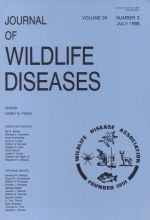Campylobacter jejuni was isolated from 44 of 313 free-living birds from Japan. The highest isolation rate was found in 30 of 87 (34%) crows (Corvus levaillanti and Corvus corone), followed by 2 of 10 (20%) blue magpies (Cyanopica cyanus), 5 of 35 (14%) gray starlings (Sturnus cineraceus), 2 of 16 (13%) domestic pigeons (Columba livia domestica), 4 of 36 (11%) bulbuls (Hypsipetes amaurotis), and 1 of 62 (2%) eastern turtledoves (Streptopelia orientalis). One-fourth of the contents of the crop and stomach of the crows was human refuse. One-third of the crop and stomach contents of gray starlings and blue magpies consisted of insects. More than one-half of the contents of bulbuls and eastern turtledoves were seeds and plant material. These differences in food habits may be a primary factor in the varying prevalence of C. jejuni in these respective avian species.
How to translate text using browser tools
1 July 1988
OCCURRENCE OF CAMPYLOBACTER JEJUNI IN FREE-LIVING WILD BIRDS FROM JAPAN
Kimiko Ito,
Yoko Kubokura,
Ken-ichi Kaneko,
Yukitoshi Totake,
Masuo Ogawa

Journal of Wildlife Diseases
Vol. 24 • No. 3
July 1988
Vol. 24 • No. 3
July 1988
blue magpies
bulbuls
Campylobacter jejuni
crows
eastern turtledoves
field study
free-living birds




